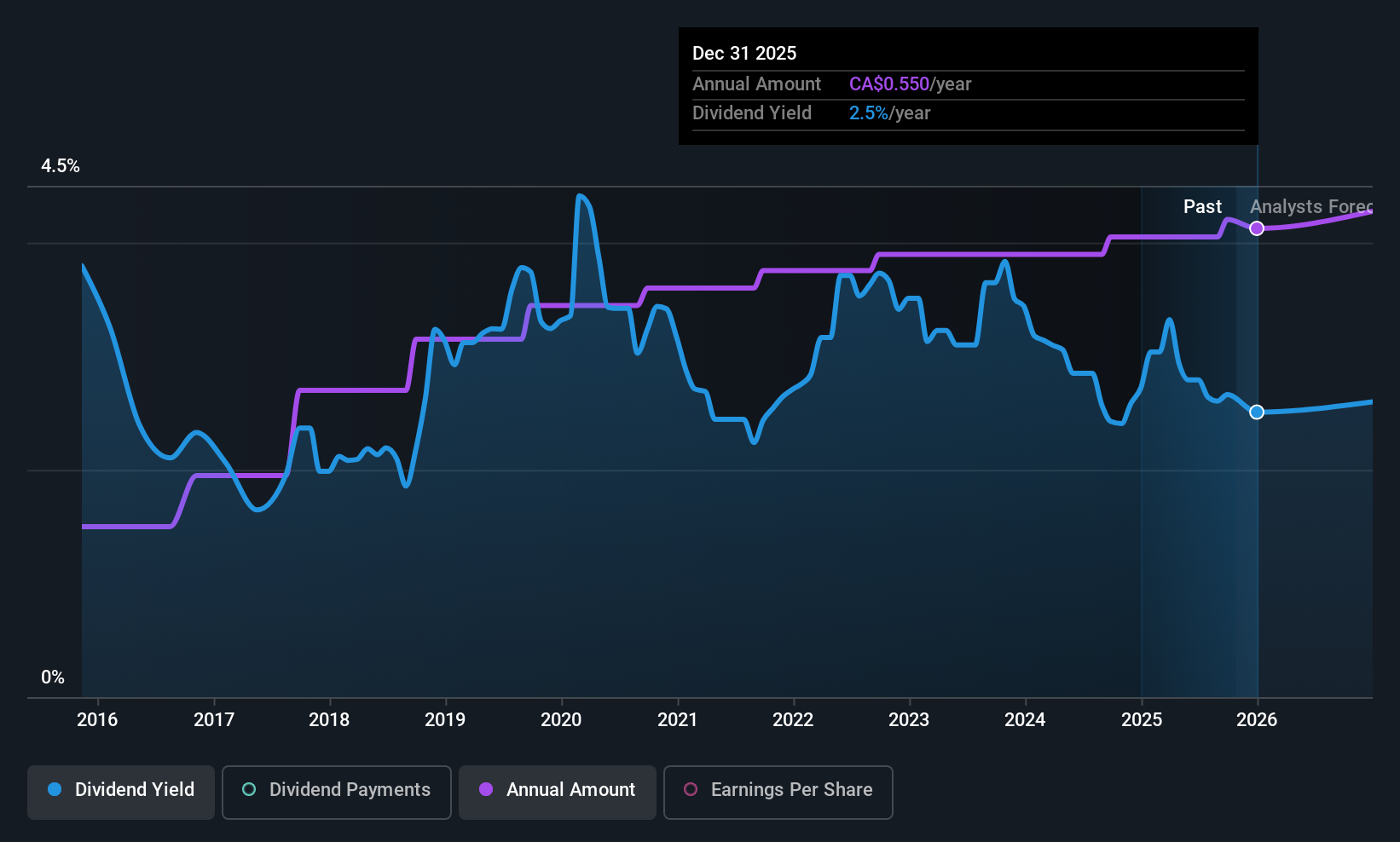Should Income Investors Look At Savaria Corporation (TSE:SIS) Before Its Ex-Dividend?
It looks like Savaria Corporation (TSE:SIS) is about to go ex-dividend in the next two days. The ex-dividend date is usually set to be one business day before the record date, which is the cut-off date on which you must be present on the company's books as a shareholder in order to receive the dividend. The ex-dividend date is of consequence because whenever a stock is bought or sold, the trade takes at least one business day to settle. Accordingly, Savaria investors that purchase the stock on or after the 31st of October will not receive the dividend, which will be paid on the 12th of November.
The company's upcoming dividend is CA$0.0467 a share, following on from the last 12 months, when the company distributed a total of CA$0.54 per share to shareholders. Based on the last year's worth of payments, Savaria stock has a trailing yield of around 2.6% on the current share price of CA$21.93. Dividends are an important source of income to many shareholders, but the health of the business is crucial to maintaining those dividends. We need to see whether the dividend is covered by earnings and if it's growing.
Dividends are usually paid out of company profits, so if a company pays out more than it earned then its dividend is usually at greater risk of being cut. Savaria paid out 70% of its earnings to investors last year, a normal payout level for most businesses. Yet cash flow is typically more important than profit for assessing dividend sustainability, so we should always check if the company generated enough cash to afford its dividend. Thankfully its dividend payments took up just 35% of the free cash flow it generated, which is a comfortable payout ratio.
It's positive to see that Savaria's dividend is covered by both profits and cash flow, since this is generally a sign that the dividend is sustainable, and a lower payout ratio usually suggests a greater margin of safety before the dividend gets cut.
Check out our latest analysis for Savaria
Click here to see the company's payout ratio, plus analyst estimates of its future dividends.

Have Earnings And Dividends Been Growing?
Companies with consistently growing earnings per share generally make the best dividend stocks, as they usually find it easier to grow dividends per share. If earnings fall far enough, the company could be forced to cut its dividend. With that in mind, we're encouraged by the steady growth at Savaria, with earnings per share up 7.3% on average over the last five years. Decent historical earnings per share growth suggests Savaria has been effectively growing value for shareholders. However, it's now paying out more than half its earnings as dividends. Therefore it's unlikely that the company will be able to reinvest heavily in its business, which could presage slower growth in the future.
Many investors will assess a company's dividend performance by evaluating how much the dividend payments have changed over time. Savaria has delivered an average of 13% per year annual increase in its dividend, based on the past 10 years of dividend payments. It's encouraging to see the company lifting dividends while earnings are growing, suggesting at least some corporate interest in rewarding shareholders.
To Sum It Up
Has Savaria got what it takes to maintain its dividend payments? While earnings per share growth has been modest, Savaria's dividend payouts are around an average level; without a sharp change in earnings we feel that the dividend is likely somewhat sustainable. Pleasingly the company paid out a conservatively low percentage of its free cash flow. To summarise, Savaria looks okay on this analysis, although it doesn't appear a stand-out opportunity.
In light of that, while Savaria has an appealing dividend, it's worth knowing the risks involved with this stock. Every company has risks, and we've spotted 2 warning signs for Savaria you should know about.
A common investing mistake is buying the first interesting stock you see. Here you can find a full list of high-yield dividend stocks.
New: Manage All Your Stock Portfolios in One Place
We've created the ultimate portfolio companion for stock investors, and it's free.
• Connect an unlimited number of Portfolios and see your total in one currency
• Be alerted to new Warning Signs or Risks via email or mobile
• Track the Fair Value of your stocks
Have feedback on this article? Concerned about the content? Get in touch with us directly. Alternatively, email editorial-team (at) simplywallst.com.
This article by Simply Wall St is general in nature. We provide commentary based on historical data and analyst forecasts only using an unbiased methodology and our articles are not intended to be financial advice. It does not constitute a recommendation to buy or sell any stock, and does not take account of your objectives, or your financial situation. We aim to bring you long-term focused analysis driven by fundamental data. Note that our analysis may not factor in the latest price-sensitive company announcements or qualitative material. Simply Wall St has no position in any stocks mentioned.
About TSX:SIS
Savaria
Provides accessibility solutions for the elderly and physically challenged people in Canada, the United States, Europe, and internationally.
Established dividend payer with reasonable growth potential.
Market Insights
Community Narratives



